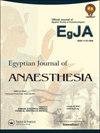Pressure versus volume-controlled ventilation with BASKA mask airway in laparoscopic cholecystectomy: A randomized clinical study
IF 0.5
Q3 ANESTHESIOLOGY
引用次数: 0
Abstract
ABSTRACT Background The best ventilation mode that suits with LMAs is still unclear. In this study, we investigated the ventilatory performance of Baska masks in patients who underwent elective laparoscopic cholecystectomy under general anaesthesia and pneumoperitoneum with either volume-controlled ventilation (VCV) or pressure-controlled ventilation (PCV) mode. Methods Fifty-Six patients with ASA I – II, who underwent laparoscopic cholecystectomy, were randomly classified into VCV (n = 28) and PCV (n = 28) groups. The lung was ventilated with a tidal volume of 8 ml/kg in the VCV group. It was ventilated initially using an inflating pressure that delivered a tidal volume of 8 ml/kg with a maximum of 35 cmH2O in the PCV group. The primary outcome was the intraoperative oropharyngeal leak pressure (OLP) of the Baska mask. Secondary outcomes were intraoperative lung mechanics, arterial carbon dioxide levels, and perioperative adverse effects. Results After pneumoperitoneum inflation, the OLP, peak inflation pressure (PIP), mean pressure (Pmean), PaCO2, and end-tidal CO2 significantly increased, and the calculated dynamic compliance significantly decreased in both ventilation modes. All variables partially returned to baseline after pneumoperitoneum deflation. Patients ventilated with PCV mode demonstrated significantly lower PIP and PaCO2 levels but higher dynamic compliance with statistically comparable OLP-PIP difference and higher leak fraction. Conclusion In this study, Patients ventilated with PCV mode showed lower PIP and PaCO2 but higher dynamic compliance, and higher leak fraction. However, both modes investigated provided effective Baska mask ventilation and maintained the OLP throughout the procedure with a statistically comparable OLP-PIP difference.腹腔镜胆囊切除术中BASKA面罩气道压力与容量控制通气的随机临床研究
本文章由计算机程序翻译,如有差异,请以英文原文为准。
求助全文
约1分钟内获得全文
求助全文
来源期刊

Egyptian Journal of Anaesthesia
Medicine-Anesthesiology and Pain Medicine
CiteScore
0.90
自引率
0.00%
发文量
78
 求助内容:
求助内容: 应助结果提醒方式:
应助结果提醒方式:


